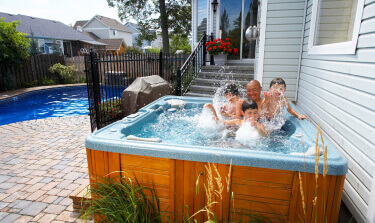Are Hot Tubs Worth It?
Hot tubs are a popular addition for homeowners who want to enhance relaxation, improve wellness, and enjoy year-round use in moderate climates. They offer a more affordable and lower-maintenance alternative to pools while still delivering hydrotherapy benefits. Whether placed in a backyard, patio, or deck, hot tubs serve as both a luxurious retreat and a functional investment that may increase home value.
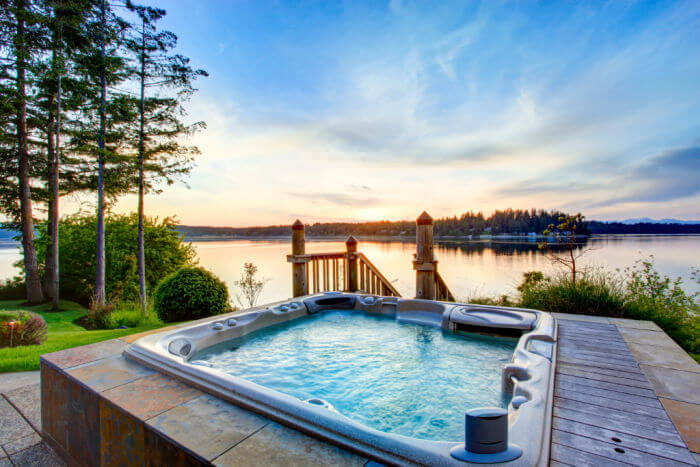
What Is a Hot Tub?
A hot tub is a self-contained spa that holds heated water and uses jets to provide therapeutic massage. Most modern hot tubs are above-ground and made from durable materials like acrylic or fiberglass, encased in cabinets that may mimic wood or stone. These tubs typically sit on a level concrete pad or reinforced deck, ensuring support for the weight of the water and occupants.
Core components of a hot tub include:
- Shell: The interior basin, often made from molded acrylic or rotomolded plastic.
- Cabinet: The exterior housing that protects internal components.
- Jets and Pumps: Provide water circulation and therapeutic massage.
- Heater: Maintains a consistent water temperature.
- Filtration System: Keeps the water clean and safe.
- Control Panel: Allows users to manage temperature, jet functions, and lighting.
Frequently Asked Questions
What Are the Different Types of Hot Tubs?
There are several types of hot tubs suited to different preferences, budgets, and spaces:
- Above-Ground Hot Tubs: These are the most popular option for homeowners thanks to their versatility and ease of installation. They come in a range of shapes, sizes, and styles, and are typically made from acrylic or rotomolded plastic. Because they sit above the ground, these hot tubs can be relocated more easily than other types, making them ideal for renters or those planning to move. They also tend to have a wide array of features and seating configurations.
- Rotomolded Hot Tubs: Made from a single piece of rotationally molded plastic, these hot tubs are durable, lightweight, and highly portable. They’re typically less expensive than acrylic models, though they may offer fewer luxury features and a more basic aesthetic. Their rugged build makes them a great choice for cabins, vacation homes, or colder climates.
- In-Ground Hot Tubs: These permanent fixtures are often integrated into patios or pool decks, offering a seamless and upscale aesthetic. They require professional installation, permits, and potentially complex plumbing and electrical work, which increases the overall cost. However, they can be fully customized with materials like stone or tile and often blend beautifully with landscaping.
- Inflatable Hot Tubs: A budget-friendly and temporary solution, inflatable hot tubs are made from durable vinyl and can be inflated or deflated as needed. They’re easy to store and move but lack advanced features like high-powered jets or precise temperature control. These are best suited for seasonal use or small spaces where a permanent setup isn’t feasible.
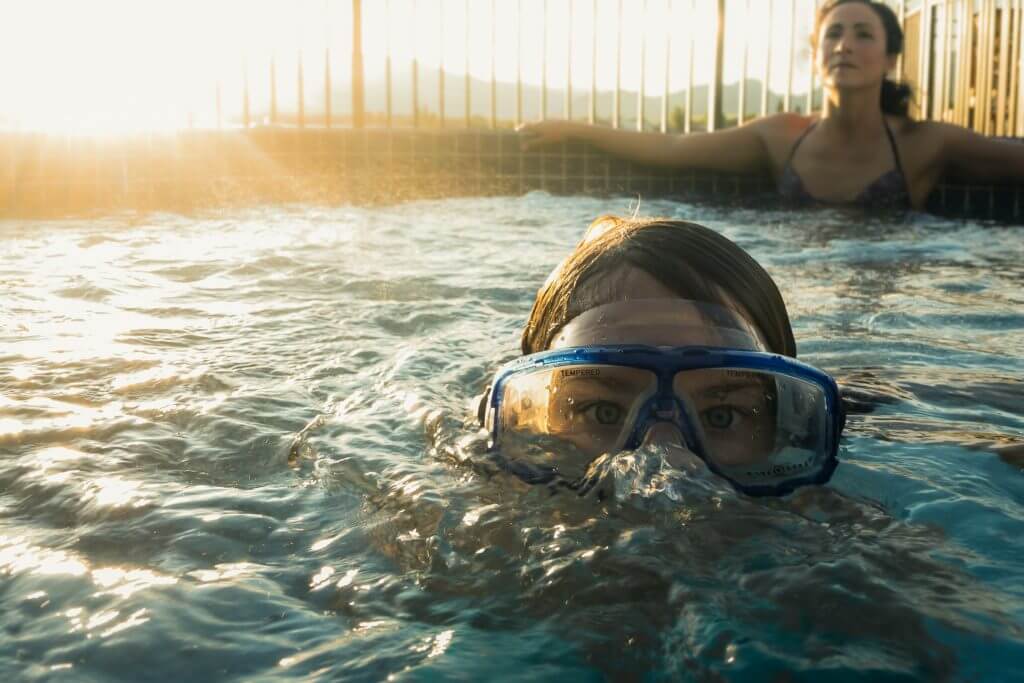
Other Types
- Saltwater Hot Tubs: Instead of traditional chlorine, these hot tubs use a salt chlorine generator to maintain clean water. The result is softer, gentler water with lower levels of harsh chemicals. Saltwater systems can reduce skin and eye irritation and require less frequent maintenance, though they come with a higher upfront cost.
- Swim Spas: Combining the benefits of a hot tub and a swimming pool, swim spas are long and narrow units with powerful jets that allow users to swim in place. They also include a heated spa section for relaxation. Swim spas are ideal for fitness enthusiasts or homeowners with limited space who want both exercise and hydrotherapy options in one unit.
Frequently Asked Questions
Topics to Explore
What Are the Benefits of a Hot Tub?
Though hot tubs are well-known for their recreational use, there are other therapeutic reasons to add one to your backyard, pool area, or even a dedicated area inside your home. The benefits of a hot tub installation include:
- Relaxation: Anyone who has ever slipped into a warm bath can attest to the relaxation the hot water can provide. Add in hydrotherapy massage jets and the constant warm temperature, and feeling tense muscles relax is a given.
- Better Sleep: As your temperature drops after a good soak, your body relaxes into a state that can provide much better sleep.
- Improved Mobility: According to the Arthritis Foundation, time in a hot tub can improve quality of life. Taking advantage of warm water two or three times a week can help individuals move around better and experience up to 40% less pain.
- Other Health Improvements: A hot tub can help with things other than sleep and mobility. A 30 minute soak can improve heart function and reduce depressive symptoms as well.
- Increase in Family Time: Just as with an outdoor patio, porch or other gathering place, a hot tub with plenty of room provides a good opportunity for the whole family to get together and spend quality time.
- Increased Socialization: It’s not just your family that will enjoy the spa. Your hot tub will draw neighbors and friends like flies to honey. Expect to become quite popular!
Choosing the Right Hot Tub for Your Home
When selecting a hot tub, homeowners should consider a range of factors that influence long-term satisfaction and performance:
- Durability: Choose a hot tub made with high-quality materials such as acrylic or multi-layer fiberglass. A well-constructed tub resists cracking, UV damage, and staining. Full foam insulation not only enhances energy efficiency but also supports plumbing lines, helping to extend the life of the tub.
- Aesthetic Appeal: A hot tub is a visual centerpiece in your yard or patio. Select a cabinet style, texture, and color that complements your outdoor environment. Many modern tubs offer wood-look panels or stone-inspired finishes that blend naturally into landscaped spaces.
- Functionality: Consider how you plan to use your hot tub. For therapeutic use, prioritize models with strategically placed jets, ergonomic seating, and adjustable controls. If you entertain often, choose a tub with multiple seating arrangements, cup holders, and LED lighting. Smart controls, Wi-Fi integration, and touchscreen panels offer convenience and customization.
- Budget: Hot tubs are available at a wide range of price points. Entry-level models typically offer basic features and smaller sizes, while premium models can include extensive jet systems, entertainment packages, and luxury materials. Don’t forget to factor in the cost of installation, monthly utilities, and long-term maintenance, such as filters and chemical treatments.
Consulting with a qualified contractor or hot tub retailer can help you explore your options and determine which model aligns best with your lifestyle, space, and budget.
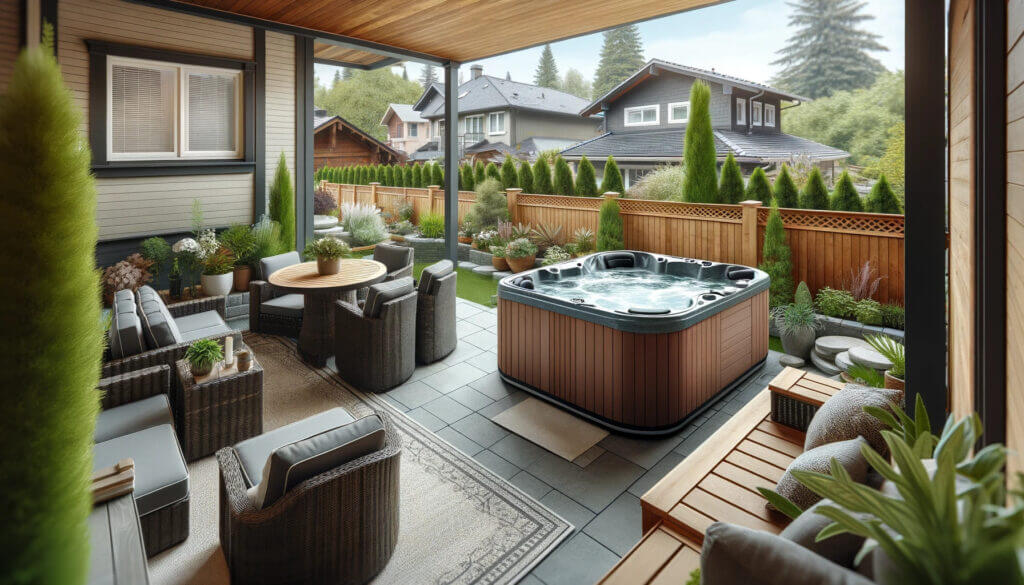
Features to Look for in a Hot Tub
Today’s hot tubs offer a wide range of customizable features and accessories. Key options include:
- Lounge Seats: Allow full-body reclining and massage.
- Adjustable Jets: Targeted relief for specific muscle groups.
- LED Lighting: Enhances ambiance and improves nighttime safety.
- Entertainment Systems: Waterproof speakers and TV screens.
- Waterfalls and Bubblers: Add a spa-like feel to your backyard.
- Touchscreen Controls: Intuitive settings for temperature, jets, and lighting.
- Advanced Filtration Systems: Keep water clean with minimal effort.
Frequently Asked Questions
How Much Does a Hot Tub Cost?
There are many points to consider when it comes to the cost of hot tubs. The size, cover, shell material, number of jets and pumps, size of the heater, and much more come into play.
Upfront Installation Costs
In terms of upfront installation costs for a new hot tub, there are some basic price ranges you can expect:
- Small (2-3 person): $3,000 to $5,000
- Medium (5-7 person): $5,000 to $12,000
- Large (8-10 person): $9,000 to $20,000
Keep in mind that these are the base prices for materials. Installation fees may be involved depending on your hot tub installer and your geographical area. However, installation for most hot tubs is usually inexpensive. This is especially the case if it is an above-ground model and there is already a suitable concrete pad, patio, or other level surface that can support the weight.
Upkeep and Maintenance Costs
All hot tub spas need to be maintained properly and cleaned routinely, which involves ongoing costs after paying for installation. Maintenance costs for hot tubs include the increase in your electric bill, which should be modest with smaller spas.
Keep in mind that hot tubs are usually more expensive to heat during the winter than summer. The more you use it during any season, the more you will run the heater. There will also be the cost of basic monthly cleaning and maintenance, including water filtration and chemicals. Water care systems that are built into the hot tub can involve a higher up-front price tag, but a lower monthly cost. All in all, most homeowners see about a $25 to $50 increase in monthly utility bills depending on how often they use the hot tub. Hot tub service professionals will charge about $100 to $150 per monthly visit to maintain, clean, and treat your hot tub’s water with chemicals.
Frequently Asked Questions
Topics to Explore
How to Maintain Your Hot Tub
Ongoing care is key to longevity and safety. Proper hot tub maintenance protects your investment, ensures clean and safe water, and keeps all systems functioning as intended. Here are the most important maintenance steps and why they matter:
- Test and Balance Water Chemistry Weekly: Use a test strip or liquid testing kit to check pH, alkalinity, and sanitizer levels. Keeping chemicals balanced helps prevent bacteria growth and protects hot tub components from scale or corrosion.
- Clean Filters Every 1 to 2 Weeks: Rinse filters under a hose or soak them in a filter cleaner to remove debris and oils. Clean filters help maintain water clarity and reduce strain on pumps and heaters.
- Drain and Refill Every 3 to 4 Months: Over time, minerals and contaminants build up in the water. Regular draining refreshes the system and ensures clean water. For heavy use, consider draining more frequently.
- Inspect for Leaks or Wear: Check jets, seals, plumbing lines, and the cabinet for any signs of leakage, cracks, or deterioration. Catching issues early can prevent costly repairs.
- Use a Quality Hot Tub Cover: A well-insulated, secure-fitting cover keeps debris out, retains heat, and helps reduce energy use. Always keep it closed when not in use to maximize efficiency.
- Schedule Professional Servicing Annually: An annual inspection by a hot tub technician ensures all components are working properly. Pros can check hidden issues like worn pumps or loose electrical connections that aren’t visible during routine owner checks.
Following these steps consistently helps maintain water hygiene, optimize performance, and extend the life of your hot tub system. Keeping a simple maintenance log or reminder schedule can be helpful for tracking tasks over time.
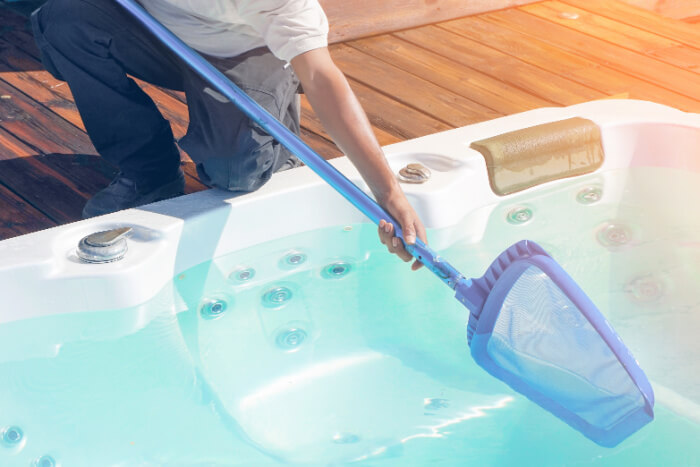
Frequently Asked Questions
Common Issues and Troubleshooting Tips for Hot Tubs
Hot tubs, like any complex home system, may occasionally experience performance issues. Understanding the most common problems and how to troubleshoot them can help you maintain a safe and enjoyable soaking experience:
- Cloudy Water: This is often caused by imbalanced chemicals, dirty filters, or inadequate filtration cycles. Start by testing and adjusting pH, alkalinity, and sanitizer levels. Clean or replace filters and ensure the circulation pump is running long enough each day.
- Low Jet Pressure: If jets feel weak or are not flowing evenly, it could be due to clogged jets, airlocks in the plumbing, or low water levels. Remove and clean jet inserts if accessible. Refill the tub if water is below the recommended level, and try releasing airlocks by loosening the pump union or cycling the jets.
- Heater Not Working: This may result from tripped breakers, a blown fuse, thermostat failure, or scale buildup. First, check the power source and reset any tripped GFCI outlets. If the issue persists, consult your owner’s manual or call a technician to inspect the heater and electrical components.
- Error Codes: Hot tubs use digital displays to indicate system issues, such as flow errors, overheating, or low voltage. Refer to the manufacturer’s manual to decode and address the specific error. In many cases, a quick reset or chemical adjustment can resolve the issue, but ongoing problems should be reviewed by a professional.
- Leaks: Water pooling around the base of your hot tub may indicate a loose fitting, cracked plumbing, or failing gasket. Visually inspect plumbing connections, cabinet seams, and pump housing. For internal or persistent leaks, professional leak detection and repair are recommended.
Promptly addressing these issues helps extend the lifespan of your hot tub and avoids more extensive repairs down the line. If you’re unsure or the issue persists after basic troubleshooting, always consult a certified technician for assistance.
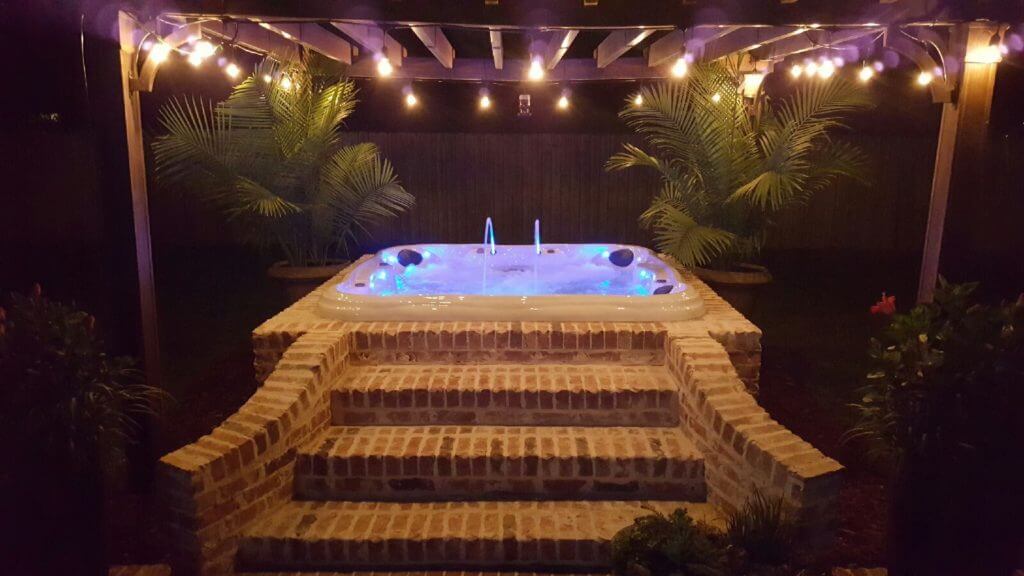
Frequently Asked Questions
What to Do After Installing or Replacing a Hot Tub
Once your hot tub is installed, take the following steps to ensure safe and optimal use:
- Confirm all systems are functioning correctly. Turn on the jets, lights, and heater to ensure everything is operating as expected. Listen for unusual noises and check for any warning lights or error codes.
- Most manufacturers require product registration to activate your warranty. Take note of warranty terms and keep all documentation organized in case you need repairs or replacements.
- Arrange for a professional inspection within the first month to confirm that plumbing, electrical, and heating systems are functioning properly. Set reminders for ongoing filter cleaning, water testing, and seasonal maintenance.
- Familiarize yourself with how to adjust temperature, activate jets, and manage filtration cycles. Also review built-in safety features such as lock modes or temperature limits, especially if children will be using the tub.
- If issues arise, having a trusted point of contact can save time and ensure repairs are handled by someone familiar with your system.
- Add the appropriate startup chemicals, balance the water, and set a schedule for routine testing and adjustments. Clean, balanced water is essential for both safety and system performance.
- Make sure anyone using the hot tub understands proper usage, including avoiding extended soaking at high temperatures and maintaining clean skin before entering.
Frequently Asked Questions
Ready to get your project started?
Let us find the best Hot Tubs pros in your area, then easily request quotes, book a contractor, and get the job done. It's that easy.

Homeowner Resources
Here are the top articles that homeowners found useful when planning their Hot Tubs project and navigating the contractor hiring process.
- The Best Hot Tub Accessories
- Is it Worth It to Buy a Used Hot Tub?
- Calculating Your Hot Tub ROI
- Understanding 110V vs. 220V Hot Tubs
- When is the Best Time to Buy a Hot Tub?
- Hot Tubs: Maintenance and Care
- Budgeting for Your Hot Tub
- What to Expect During Your Hot Tub Installation
- Improving the Energy Efficiency of Hot Tubs
- Backyard Hot Tub Ideas for 2025
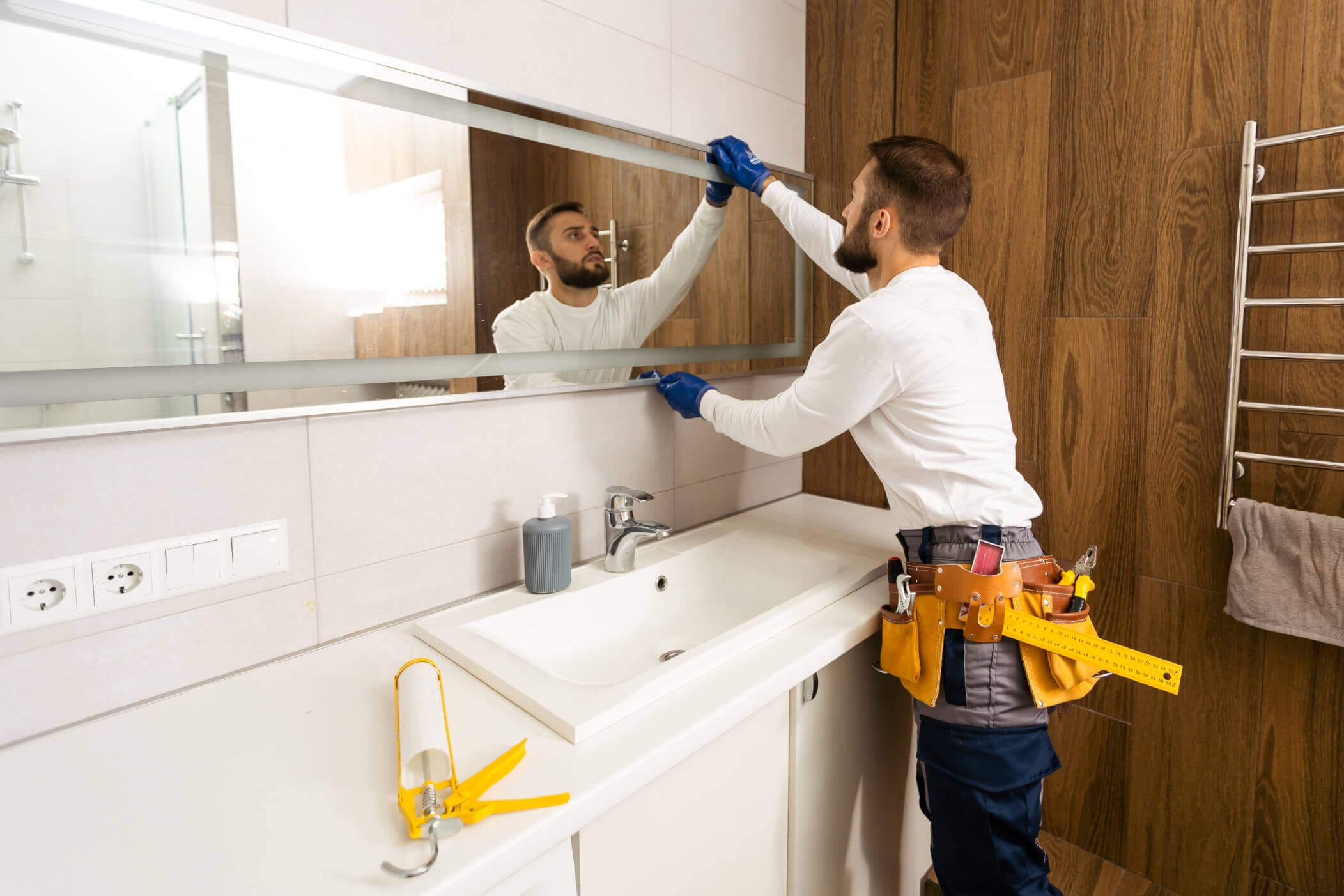
Real Stories, Real Success
See how our solutions empower homeowner projects and experiences.
